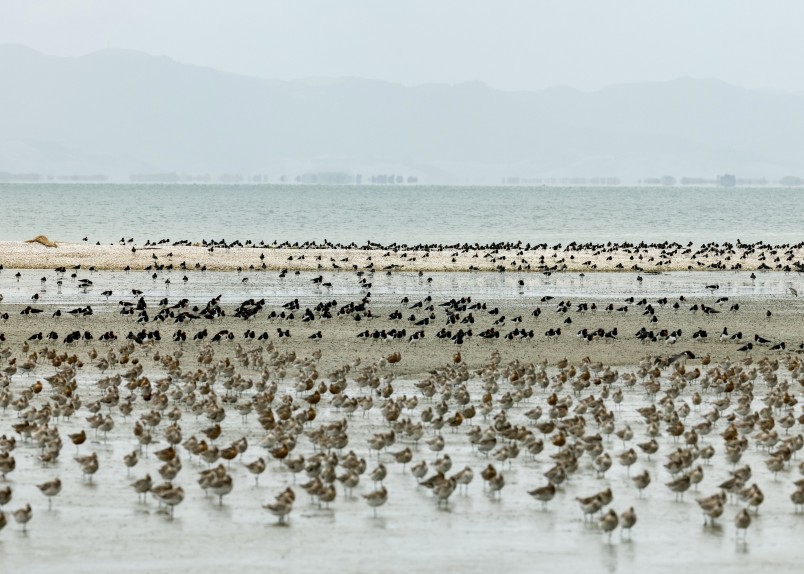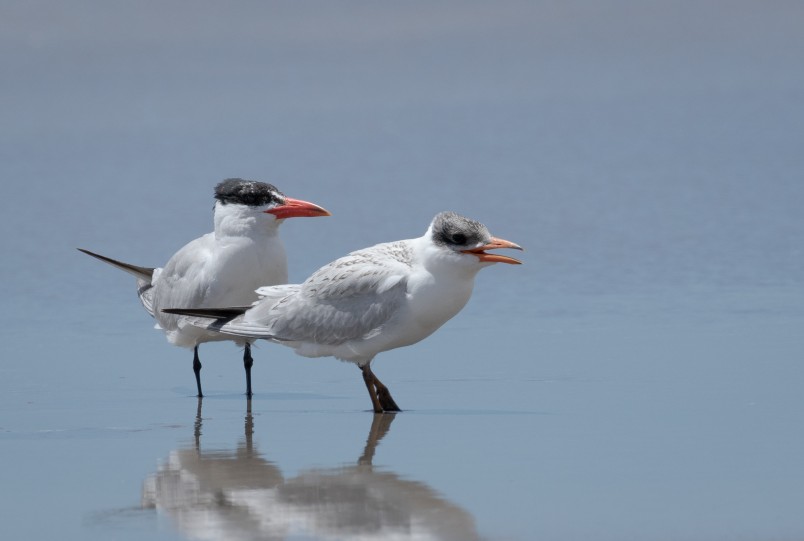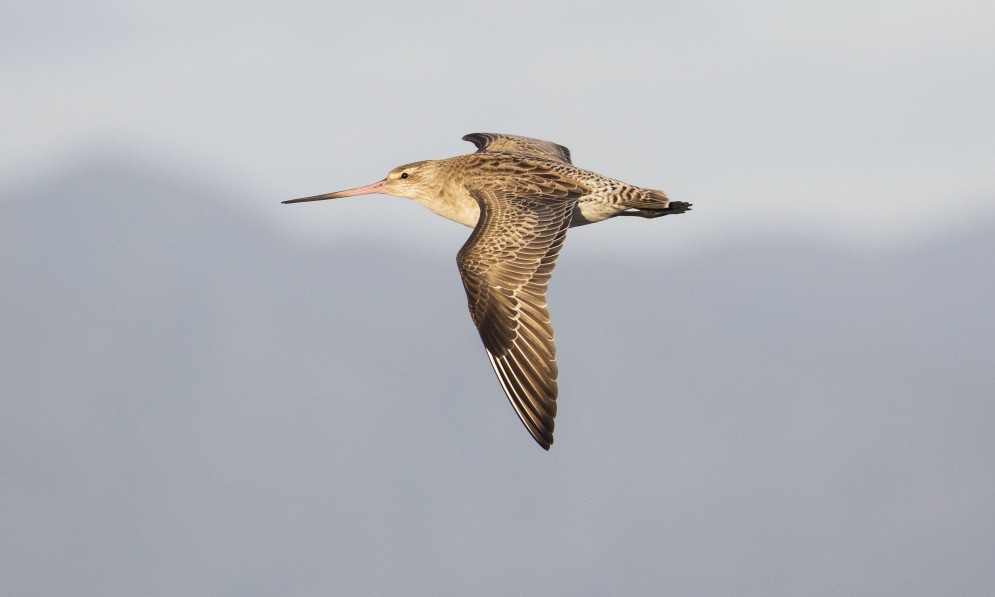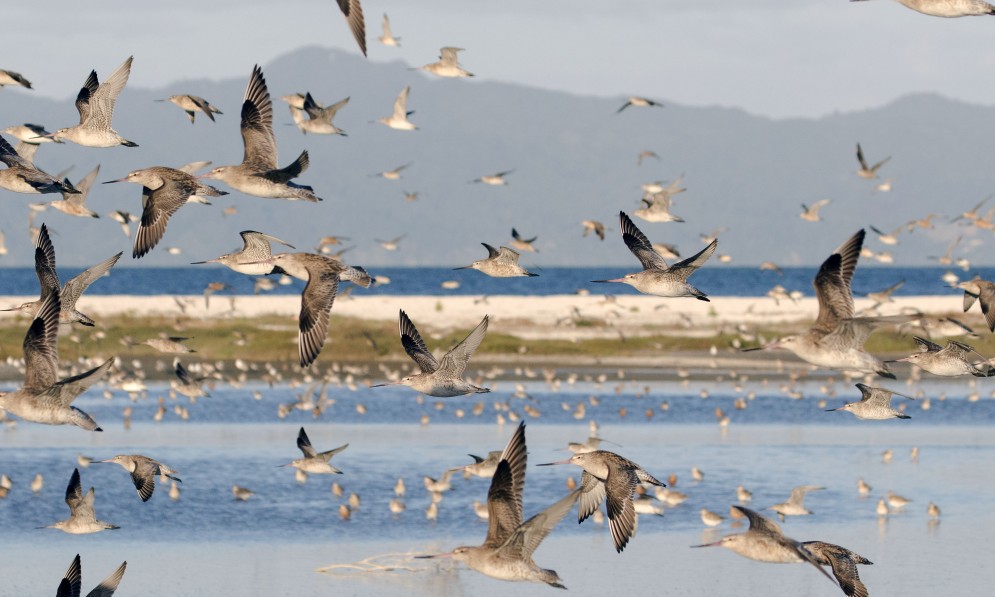David Brooks heads to Pūkorokoro Miranda Shorebird Centre, where the last of the kuaka were preparing to fly 10,000km to their breeding grounds in Alaska.
Forest & Bird magazine
A version of this story was first published in the Winter 2021 issue of Forest & Bird magazine.
A great swirling flock of thousands of shorebirds is not a common sight, but if you get the timing right during a visit to Pūkorokoro Miranda at the southern end of the Firth of Thames you will likely have an amazing experience.
A couple of hours either side of high tide is the time to go, when the birds’ feeding grounds on the vast mudflats are covered by water and they gather close to the shore.
As we walked along the path through a wetland towards Miranda’s godwit hide, thousands of wading birds came into view, resting and preening on mud just below a shellbank at the water’s edge. The old saying “birds of a feather stick together” came to mind, as the different species gathered in their own distinct groups.
An exception were the bar-tailed godwits and red knots, some showing distinctive red-brown breeding plumage, which mixed together in a long distinct tawny band along the shore.
Most of the kuaka godwits were asleep, their long pink and black bills tucked into their back feathers. With many facing an imminent 10,000km non-stop journey to China and Korea, rest seemed a good option.

Kuaka godwits and huahou red knots gather ready for their migration, while tōrea pango oystercatchers look on, Pūkorokoro Miranda. Credit Stephen Leaper
Beyond them, closer to the shellbank was a vast group of South Island pied oystercatchers, standing out with their bold black and white plumage and bright orange beaks. Another huge group of soft grey and white feathered wrybills were – like the oystercatchers – more recent arrivals from South Island breeding grounds.
Suddenly and without any obvious reason – a harrier hawk nearby perhaps – they were all in the air, thousands of beating wings obscuring the Coromandel Range to the east. They headed east over the water, turned and circled warily a couple of times, before returning to the ground.
At the start of March, the Pūkorokoro Miranda Naturalists Trust had counted around 4300 godwits, although when we visited three weeks later the annual migration to the northern hemisphere had already been under way for two weeks.
But hundreds remained, as well as large numbers of red knots, of which 1075 were recorded earlier in the month.
The South Island pied oystercatchers – 4300 at the start of the month – and wrybills (1900) now dominated the mud flats, after returning during summer from their inland South Island breeding grounds.

Taranui Caspian Terns. Credit Mike Vincent
Our visit coincided with the Trust’s Migration Day – postponed because of Covid restrictions – to mark the annual migration of the godwits and other shorebirds that breed in Alaska or Siberia.
Volunteers at the viewing hides answered visitors’ questions and set up spotting scopes – like small telescopes – to allow close up views of the birds and pinpoint some of the rarer migratory species.
“Would you like to see a far-eastern curlew?”, a volunteer asked. “Have a look through the spotting scope, just past the white-faced herons and there’s another one further to the left.”
And there they were, with improbably long downward curved bills on the edge of the flock of wrybills. Another volunteer helped us spot a handful of Pacific Golden plovers, a couple showing distinctive black, white, and gold breeding plumage.
Gatherings of shorebirds in large numbers is not unique to Miranda, but its geography makes it one of the best places to view the birds. For a start, there’s the surrounding 8500ha of mudflats, where there are rich pickings of crabs, worms, and shellfish.
The flats below the hills at Miranda are a rare geological feature known as a chenier plain. Waves have pushed shells and sand into ridges on the shoreline over thousands of years. Over time, the gaps between these ridges have filled with silt and a new ridge is formed on the shoreline, providing an ideal bird roosting site at high tide.
The Pūkorokoro Miranda Naturalists Trust was set up in 1975, and in 1990 it opened its Shorebird Visitor’s Centre, a trove of information about the birds, their habitat, and the threats they face. The trust is also involved in research and education and works to protect and improve the birds’ habitat.

Kuaka bar-tailed godwit. Credit John Oates.
The godwits – named as Forest & Bird’s Bird of the Year in 2015 – get star billing because of their huge numbers and their heroic non-stop flights. The birds’ endurance, including a flight of around 10,000km to mudflats in Asia en route to breeding grounds in Alaska is astonishing enough. But the return journey – non-stop, more than 11,000km over eight or nine days – is even more impressive.
Last year (2020), a satellite tracker recorded one godwit – blown slightly off course by unfavourable winds – flying 12,200km in 9.3 days, reaching speeds of around 100km an hour on its way back to New Zealand. This is believed to be the longest distance recorded for a non-stop flight by a bird.
The number of godwits coming to New Zealand has declined from around 100,000 recorded in the 1980s to around 74,500 in 2019. The main cause of the decline is believed to be development of mud flats in South Korea and China.
The good news is that international efforts to protect them and their Asian feeding sites is being coordinated through the East Asian-Australasian Flyway Partnership, of which the Miranda Trust is a member.
Pūkorokoro-Miranda
Pūkorokoro-Miranda is just 90km from Auckland. For those who want to spend more than a couple of hours observing the birds and exploring the area, accommodation is available at the Shorebird Visitors Centre. The nearby Miranda Holiday Park also has a range of accommodation.

